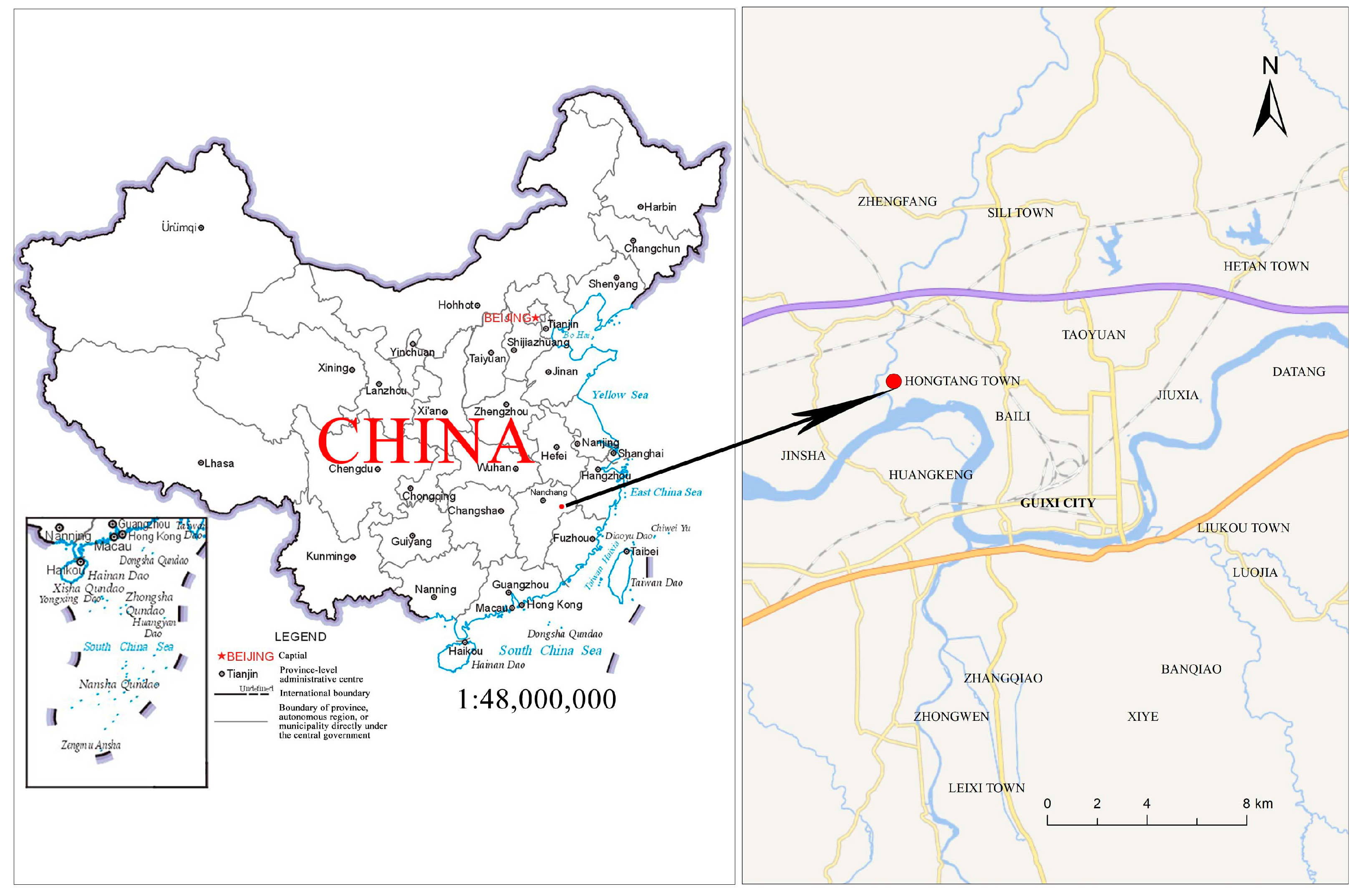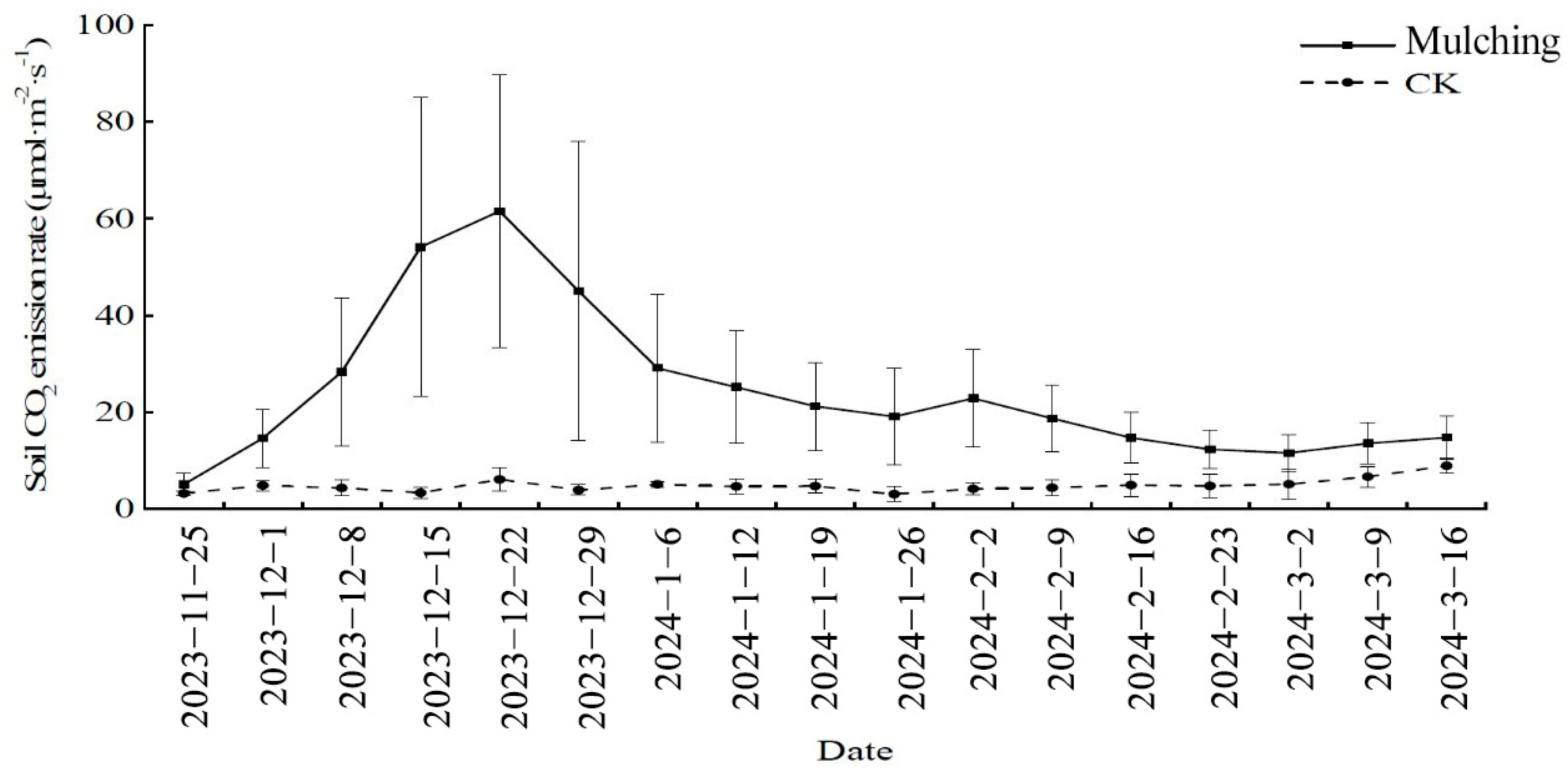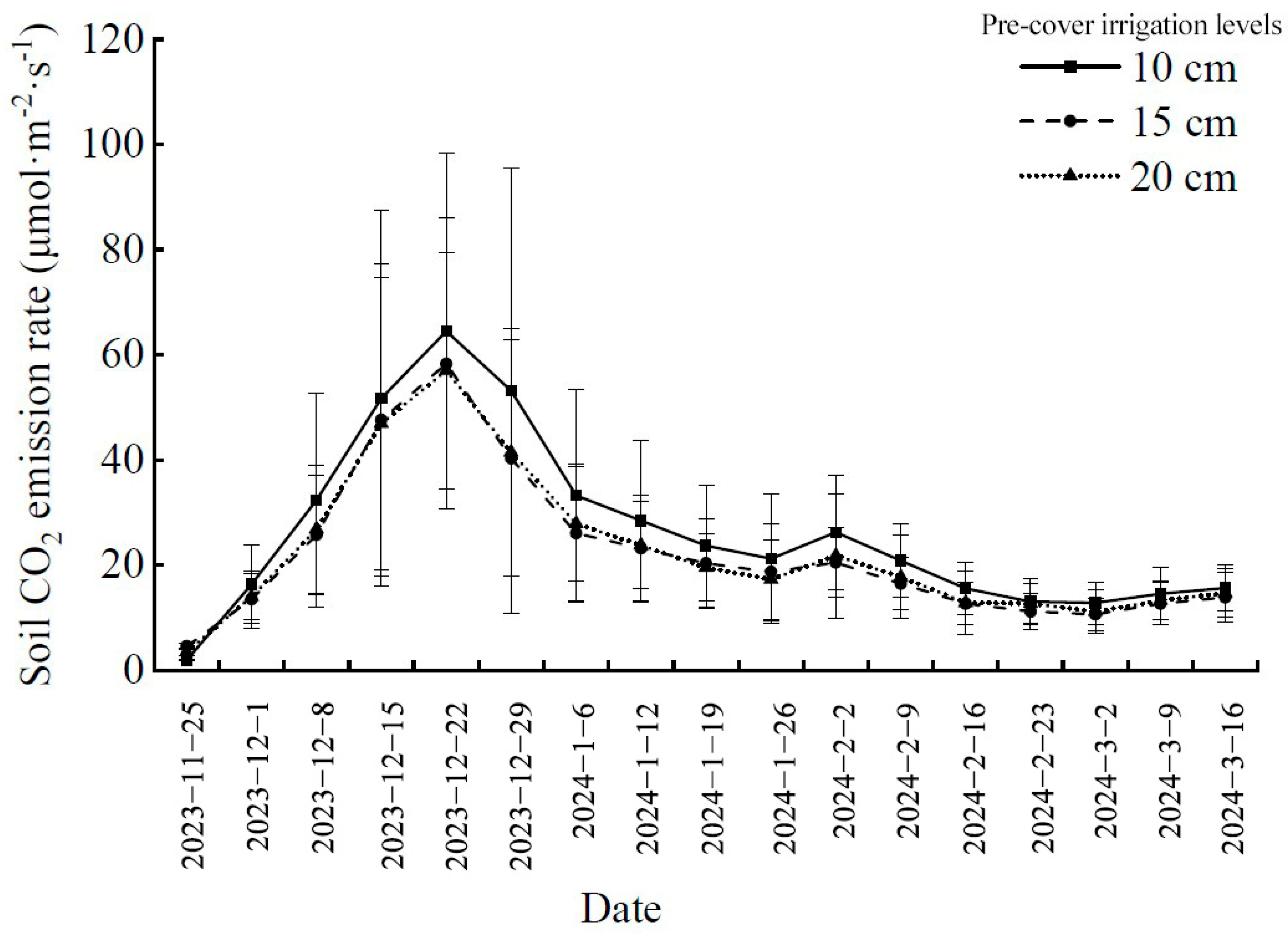Effects of Forest Land Mulching on the Soil CO2 Emission Rate of Phyllostachys violascens Forests
Abstract
1. Introduction
2. Materials and Methods
2.1. Overview of the Experimental Area
2.2. Experimental Methods
2.2.1. Experimental Design
2.2.2. Plot Setup
2.2.3. Plot Coverage
2.3. Measurement of Soil CO2 Emission Rate
2.4. Data Processing
3. Results
3.1. Dynamics of Soil CO2 Emissions in Covered Leizhu Bamboo Forests
3.2. Impact of Covering Measures on Soil CO2 Emissions
3.3. Impact of Covering Measures on Dynamic Changes in Soil CO2 Emissions
3.3.1. Dynamic Changes in Soil CO2 Emission Rates with Different Heat-Generating Materials
3.3.2. Impact of Rice Husk Layer Thickness on Soil CO2 Emission Dynamics
3.3.3. Impact of Pre-Cover Irrigation on Soil CO2 Emission Dynamics
4. Discussion
4.1. Significant Impact of Land Cover on Soil CO2 Emissions in Leizhu Bamboo Forests
4.2. The Thickness of the Husk Layer and Pre-Cover Soil Moisture Are Major Factors Influencing Soil CO2 Emission Rates
4.3. The Type of Heat-Generating Material Mainly Affects the Dynamic Variation Pattern of Soil CO2 Emission Rates
5. Conclusions
Author Contributions
Funding
Data Availability Statement
Conflicts of Interest
References
- Batjes, N.H. Total carbon and nitrogen in the soils of the world. Eur. J. Soil Sci. 2014, 65, 10–21. [Google Scholar] [CrossRef]
- Jenkinson, D.S.; Adams, D.E.; Wild, A. Model estimates of CO2 emissions from soil in response to global warming. Nature 1991, 351, 304–306. [Google Scholar] [CrossRef]
- Hansen, J.E.; Lacis, A.A. Sun and dust versus greenhouse gases: An assessment of their relative roles in global climate change. Nature 1990, 346, 713–719. [Google Scholar] [CrossRef]
- Raich, J.W.; Potter, C.S. Global patterns of carbon dioxide emissions from soils. Glob. Biogeochem. Cycles 1995, 9, 23–26. [Google Scholar] [CrossRef]
- Cheng, H.; Shen, Z.; Chen, Y.; Shen, X.G.; Hui, L.D.; Long, Z.R.; Li, Z.R. Mulching effect of oil cake, chaff and moisture on soil temperature of Phyllostachys edulis ‘Pachyloen’ forest. Non-Wood For. Res. 2020, 38, 169–176. [Google Scholar]
- Yang, B.; Shen, Z.; Shen, X.; Chen, Y.; Long, Z.; Li, Z. The heating law of different heating substances and its effect on soil temperature of cover Phyllostachys violascens forest. J. Cent. South Univ. For. Technol. 2021, 41, 89–96. [Google Scholar]
- Han, X.; Dang, P.; Liao, L.; Song, F.; Zhang, M.; Zhang, M.; Li, G.; Wen, S.; Yang, N.; Pan, X.; et al. Combining slow-release fertilizer and plastic film mulching reduced the carbon footprint and enhanced maize yield on the Loess Plateau. J. Environ. Sci. 2025, 147, 359–369. [Google Scholar] [CrossRef] [PubMed]
- Hu, J.; Miles, D.M.; Adeli, A.; Brooks, J.P.; Podrebarac, F.A.; Smith, R.; Lei, F.; Li, X.; Jenkins, J.N.; Moorhead, R.J. Effects of cover crops and soil amendments on soil CO2 Flux in a Mississippi Corn crop system on Upland soil. Environments 2023, 10, 19. [Google Scholar] [CrossRef]
- Wang, C.; Li, S.; Wu, M.; Wang, X.; Wang, S.; Guo, Z.; Gao, L. High efficiency and low greenhouse gas emissions intensity of maize in drip irrigation under mulch system. Agric. Ecosyst. Environ. 2023, 346, 108344. [Google Scholar] [CrossRef]
- Peng, Y.; Thomas, S.; Tian, D. Forest management and soil respiration: Implications for carbon sequestration. Environ. Rev. 2008, 16, 93–111. [Google Scholar] [CrossRef]
- Porter, G.S.; Bajita-Locke, J.B.; Hue, N.V.; Strand, D. Manganese solubility and phytotoxicity affected by soil moisture, oxygen levels, and green manure additions. Commun. Soil Sci. Plant Anal. 2004, 35, 99–116. [Google Scholar] [CrossRef]
- Gao, H.; Liu, Q.; Yan, C.; Wu, Q.; Gong, D.; He, W.; Liu, H.; Wang, J.; Mei, X. Mitigation of greenhouse gas emissions and improved yield by plastic mulching in rice production. Sci. Total Environ. 2023, 880, 162984. [Google Scholar] [CrossRef] [PubMed]
- Liu, F.; Gao, M.; Zhang, H.; Yuan, H.; Zong, R.; Liu, Z.; Wei, S.; Li, Q. Response of soil CO2 emissions and water-carbon use efficiency of winter wheat to different straw returning methods and irrigation scenarios. J. Sci. Food Agric. 2024, 104, 2449–2457. [Google Scholar] [CrossRef]
- Luo, X.; Li, C.; Lin, N.; Wang, N.; Chu, X.; Feng, H.; Chen, H. Plastic film-mulched ridges and straw-mulched furrows increase soil carbon sequestration and net ecosystem economic benefit in a wheat-maize rotation. Agric. Ecosyst. Environ. 2023, 344, 108311. [Google Scholar] [CrossRef]
- Fu, X.; Wang, J.; Xie, M.; Zhao, F.; Doughty, R. Increasing temperature can modify the effect of straw mulching on soil C fractions, soil respiration, and microbial community composition. PLoS ONE 2020, 15, e0237245. [Google Scholar] [CrossRef] [PubMed]
- Wang, H.; Zheng, J.; Fan, J.; Zhang, F.; Huang, C. Grain yield and greenhouse gas emissions from maize and wheat fields under plastic film and straw mulching: A meta-analysis. Field Crops Res. 2021, 270, 108210. [Google Scholar] [CrossRef]
- Xie, M.-Y.; Shang, Y.-Q.; Zhao, F.-Z.; Wang, J. Responses of soil respiration to temperature under different mulching modes in a dryland corn field. J. Appl. Ecol. 2020, 31, 467–473. [Google Scholar]
- Zhang, M.; You, G.; Wang, Y.; Yan, R.; Zou, C.; Chen, S. Impact of intensive management on the carbon flux variation characteristics of the Lei bamboo (Phyllostachys praecox) forest. Glob. Ecol. Conserv. 2024, 50, e02794. [Google Scholar] [CrossRef]
- Mbukwa, D.; Gui, R.; Deng, S. Effect of soil organic mulching combined with aeration treatment on soil quality, nutrients content, and lei bamboo shoot production. Agriculture 2023, 13, 536. [Google Scholar] [CrossRef]
- Chen, J.; Jiang, C.; Tu, T.; Ma, R.; Hao, Q. Changes in soil greenhouse gas concentrations induced by plastic film mulching in a hot pepper–radish rotation. Int. J. Environ. Sci. Technol. 2023, 20, 11523–11536. [Google Scholar] [CrossRef]
- Visconti, F.; Peiró, E.; Pesce, S.; Balugani, E.; Baixauli, C.; de Paz, J.M. Straw mulching increases soil health in the inter-row of citrus orchards from Mediterranean flat lands. Eur. J. Agron. 2024, 155, 127115. [Google Scholar] [CrossRef]
- Wang, Y.; Tian, Z.; Li, X.; Zhang, M.; Fang, Y.; Xiang, Y.; Liu, Y.; Liu, E.; Jia, Z.; Siddique, K.H.; et al. Straw-derived biochar regulates soil enzyme activities, reduces greenhouse gas emissions, and enhances carbon accumulation in farmland under mulching. Field Crops Res. 2024, 317, 109547. [Google Scholar] [CrossRef]
- Lee, J.G.; Chae, H.G.; Das, S.; Kim, G.W.; Kim, P.J. Cover crops offset recalcitrant soil organic carbon losses under plastic-film mulching by altering microbial functional genes. Biol. Fertil. Soils 2024, 60, 35–46. [Google Scholar] [CrossRef]
- Gao, J.; Zhuang, S.; Gui, R. Subsurface aeration mitigates organic material mulching-induced anaerobic stress via regulating hormone signaling in Phyllostachys praecox roots. Front. Plant Sci. 2023, 14, 1121604. [Google Scholar] [CrossRef] [PubMed]
- Huang, T.; Wen, S.; Zhang, M.; Pan, Y.; Chen, X.; Pu, X.; Zhang, M.; Dang, P.; Meng, M.; Wang, W.; et al. Effect on greenhouse gas emissions (CH4 and N2O) of straw mulching or its incorporation in farmland ecosystems in China. Sustain. Prod. Consum. 2024, 46, 223–232. [Google Scholar] [CrossRef]
- Zhang, L.; Xu, C.; Yan, W.; Tan, G.; Sun, N.; Zhao, H.; Li, F.; Yu, J.; Meng, X.; Bian, S. Effects of surface mulching on soil water temperature, physiological characteristics and yield of maize. Int. J. Plant Prod. 2023, 17, 283–296. [Google Scholar] [CrossRef]
- Liu, Z.; Huang, F.; Wang, B.; Li, Z.; Zhao, C.; Ding, R.; Yang, B.; Zhang, P.; Jia, Z. Soil respiration in response to biotic and abiotic factors under different mulching measures on rain-fed farmland. Soil Tillage Res. 2023, 232, 105749. [Google Scholar] [CrossRef]
- Akhtar, K.; Ain, N.U.; Wang, W.; Ren, G.; Feng, Y.; Djalovic, I.; Prasad, P.V.V.; Yang, G.; He, B.; Wen, R. Straw mulch decreased nitrogen fertilizer requirements via regulating soil moisture and temperature to improve physiology, nitrogen, and water use efficiency of wheat. Agron. J. 2023, 115, 3106–3118. [Google Scholar] [CrossRef]
- Quan, H.; Wang, B.; Wu, L.; Feng, H.; Wu, L.; Wu, L.; Liu, D.L.; Siddique, K.H. Impact of plastic mulching and residue return on maize yield and soil organic carbon storage in irrigated dryland areas under climate change. Agric. Ecosyst. Environ. 2024, 362, 108838. [Google Scholar] [CrossRef]
- Hao, D.-C.; Su, X.-Y.; Xie, H.-T.; Bao, X.-L.; Zhang, X.-D.; Wang, L.-F. Effects of tillage patterns and stover mulching on N2O production, nitrogen cycling genes and microbial dynamics in black soil. J. Environ. Manag. 2023, 345, 118458. [Google Scholar] [CrossRef]
- Guo, H.; Wang, X.; Wang, Y.; Li, S. Effect of mulched drip irrigation on crop biomass and carbon fluxes in maize field. Agric. Water Manag. 2024, 303, 109016. [Google Scholar] [CrossRef]
- Song, Q.; Yang, B.; Xu, M.; Zhang, F.; Liu, Q.; Li, S. A three-year record of CO2, CH4 and N2O emissions in maize fields influenced by mulching methods on the Loess Plateau, China. Agric. Ecosyst. Environ. 2024, 367, 108963. [Google Scholar] [CrossRef]
- Wei, H.; Zhang, K.; Chai, N.; Wang, Y.; Li, Y.; Yang, J.; Harrison, M.T.; Liu, K.; Wan, P.; Zhang, W.; et al. Exploring low-carbon mulching strategies for maize and wheat on-farm: Spatial responses, factors and mitigation potential. Sci. Total Environ. 2024, 906, 167441. [Google Scholar] [CrossRef]






| Factor | F Value |
|---|---|
| Heating substances (H) | 0.705 |
| Chaff thickness (C) | 86.142 ** |
| Water recharge (W) | 3.649 * |
| H × C | 7.232 ** |
| H × W | 2.538 * |
| C × W | 5.013 ** |
| H × C × W | 1.17 |
| Week | Date | Heating Substances (H) | Chaff Thickness (C) | Water Recharge (W) | H × C | H × W | W × C | H × C × W |
|---|---|---|---|---|---|---|---|---|
| 1 | 1 December 2023 | 0.151 | 7.577 ** | 54.939 ** | 0.562 | 0.264 | 9.298 ** | 0.179 |
| 2 | 8 December 2023 | 15.870 ** | 169.507 ** | 9.432 ** | 48.377 ** | 22.251 ** | 9.512 ** | 11.360 ** |
| 3 | 15 December 2023 | 36.465 ** | 673.090 ** | 12.262 ** | 247.179 ** | 54.593 ** | 18.738 ** | 25.021 ** |
| 4 | 22 December 2023 | 7.437 ** | 204.856 ** | 3.097 | 66.008 ** | 17.942 ** | 7.031 ** | 8.226 ** |
| 5 | 29 December 2023 | 28.181 ** | 626.723 ** | 40.017 ** | 64.537 ** | 22.155 ** | 67.207 ** | 22.821 ** |
| 6 | 6 January 2023 | 4.079 * | 404.395 ** | 24.107 ** | 39.398 ** | 3.171 * | 24.453 ** | 3.603 ** |
| 7 | 12 January 2024 | 15.473 ** | 673.026 ** | 39.390 ** | 48.196 ** | 5.060 ** | 38.291 ** | 5.854 ** |
| 8 | 19 January 2024 | 21.627 ** | 196.059 ** | 12.881 ** | 14.843 ** | 2.483 | 10.515 ** | 3.210 ** |
| 9 | 26 January 2024 | 146.975 ** | 168.309 ** | 13.935 ** | 4.363 ** | 4.732 ** | 29.006 ** | 20.489 ** |
| 10 | 2 February 2024 | 23.956 ** | 333.503 ** | 36.072 ** | 37.771 ** | 18.593 ** | 15.817 ** | 9.764 ** |
| 11 | 9 February 2024 | 0.800 | 269.105 ** | 27.268 ** | 15.982 ** | 10.466 ** | 7.450 ** | 4.626 ** |
| 12 | 16 February 2024 | 17.860 ** | 93.398 ** | 12.963 ** | 2.947 * | 2.951 * | 0.957 | 3.645 ** |
| 13 | 23 February 2024 | 0.052 | 57.989 ** | 5.155 ** | 3.605 * | 1.760 | 3.809 ** | 2.964 ** |
| 14 | 2 March 2024 | 8.666 ** | 47.066 ** | 6.846 ** | 3.167 * | 2.695 * | 2.236 | 3.065 ** |
| 15 | 9 March 2024 | 3.111 | 83.279 ** | 4.466 * | 1.144 | 2.055 | 1.113 | 1.869 |
| 16 | 16 March 2024 | 22.006 ** | 79.087 ** | 4.658 * | 14.617 ** | 1.525 | 2.524 | 3.146 ** |
Disclaimer/Publisher’s Note: The statements, opinions and data contained in all publications are solely those of the individual author(s) and contributor(s) and not of MDPI and/or the editor(s). MDPI and/or the editor(s) disclaim responsibility for any injury to people or property resulting from any ideas, methods, instructions or products referred to in the content. |
© 2025 by the authors. Licensee MDPI, Basel, Switzerland. This article is an open access article distributed under the terms and conditions of the Creative Commons Attribution (CC BY) license (https://creativecommons.org/licenses/by/4.0/).
Share and Cite
Shen, Z.; Zha, D.; Zu, X.; Shi, J.; Li, Z.; Chu, S. Effects of Forest Land Mulching on the Soil CO2 Emission Rate of Phyllostachys violascens Forests. Forests 2025, 16, 106. https://doi.org/10.3390/f16010106
Shen Z, Zha D, Zu X, Shi J, Li Z, Chu S. Effects of Forest Land Mulching on the Soil CO2 Emission Rate of Phyllostachys violascens Forests. Forests. 2025; 16(1):106. https://doi.org/10.3390/f16010106
Chicago/Turabian StyleShen, Zhan, Dongping Zha, Xinglan Zu, Jianmin Shi, Zuyao Li, and Shuangshuang Chu. 2025. "Effects of Forest Land Mulching on the Soil CO2 Emission Rate of Phyllostachys violascens Forests" Forests 16, no. 1: 106. https://doi.org/10.3390/f16010106
APA StyleShen, Z., Zha, D., Zu, X., Shi, J., Li, Z., & Chu, S. (2025). Effects of Forest Land Mulching on the Soil CO2 Emission Rate of Phyllostachys violascens Forests. Forests, 16(1), 106. https://doi.org/10.3390/f16010106







